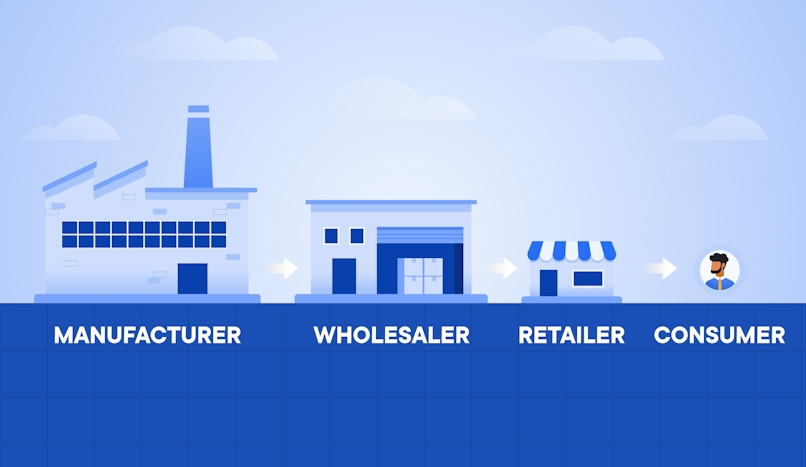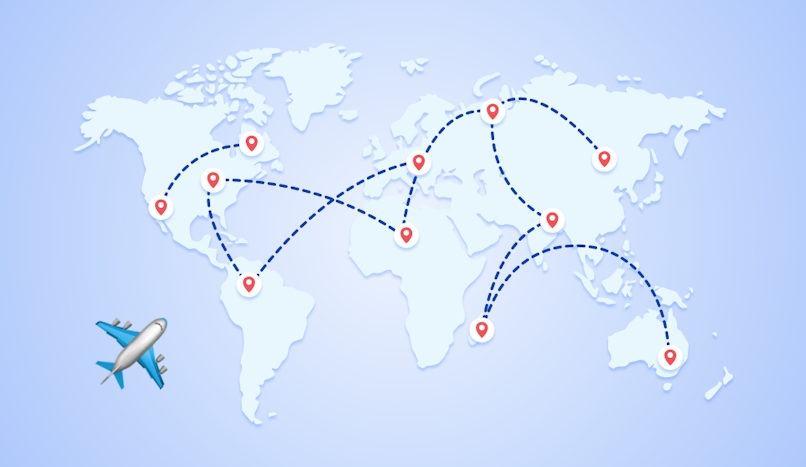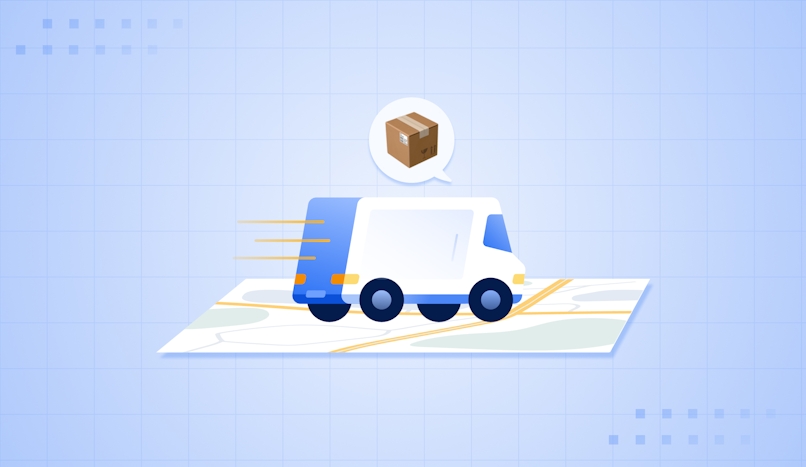Distribution vs. Logistics
Want to understand the difference between distribution and logistics? This blog explains the difference through examples.

Optimize your distribution and logistics processes with Circuit for Teams.
If you’re in the delivery business, you’ve likely heard people use the words “logistics” and “distribution.”
While the two words might seem like they mean pretty much the same thing, they are actually very different.
Consider the laptop or mobile device you’re using to read this post.
It was probably made in a factory in China, then shipped overseas to a central warehouse in the United States.
Soon after, it hopped from that central warehouse to one of several smaller warehouses spread across the country.
From there, a last-mile delivery driver picked it up and dropped it at your doorstep.
This entire process of planning and making sure that the right product is delivered to the right customer — in the right quantity and condition, at the right place and time, and at the right price — is called logistics.
On the other hand, distribution is the physical movement of a product from its point of origin to the end user (the customer).
To make it easy to understand, I’ll explain the difference between distribution and logistics services (with examples) and how your business can optimize the two processes.

What’s the difference between distribution and logistics?
Logistics and distribution are both geared toward the same goal: the efficient delivery of goods from one point to another.
But they deal with different aspects of the supply chain management process.
Logistics is the overall planning and organization of moving, storing, and cataloging products.
Distribution is the process of optimizing the physical movement of goods from production to the consumer.
Both processes deal with storage, warehousing, inventory management, and monitoring the flow and transportation of goods — but in very different ways.
While logistics is an organizational activity, distribution is the tangible part of it.
Let’s go into more detail to understand them better.
Distribution explained
Distribution is the process of making goods available to consumers when they make a purchase.
For example, products might go from the manufacturer or supplier to the point of sale — which could be the checkout counter at a retail store or a customer’s doorstep if they bought something online.
Distribution boils down to creating a path for goods to move from the manufacturer to the customer.
That path is called the distribution channel, which typically looks like this:

Distribution involves finding the best ways to move a product through each stage.
And the people involved in any of these stages might have tasks that include packaging, storage, order fulfillment, the transport of goods, and customer returns.
The overall goal of distribution is to find the most efficient and cost-effective way to transport goods to the customer.
Logistics explained
Logistics means planning, managing, coordinating, and controlling the movement of goods from point A to point B.
So, what kind of work does it involve?
Logistics covers several things, including:
- Transportation management
- Delivery management
- Warehouse management
- Material handling
- Inventory management
It takes care of planning shipping, warehousing, courier services, and transportation by road, rail, or even air freight.
There are five types of logistics solutions in supply chain management:
- Supply management: This category of logistics management involves the procurement of raw materials (for making products) from suppliers. Having raw materials at the right time is important for order fulfillment.
- Product management: This involves loading, unloading, transporting, and storing raw materials or components that make up the final product. This kind of management happens within a factory or warehouse.
- Sales logistics: Managing the delivery of finished products to distribution centers, wholesalers, and final customers is part of sales logistics.
- Customer service management (CSM): CSM takes care of customers’ needs and helps companies improve their delivery services for better customer satisfaction and retention.
- Reverse logistics: This type of logistics manages returns and refunds. So, unlike the other forms of logistics, this one deals with products flowing back into the supply chain. Customers often return damaged, unused, or unwanted products. Reverse logistics can help you figure out what to do with returned products and their packaging.
Another way to categorize these logistics systems is to divide them into inbound and outbound logistics.
Inbound logistics deals with how supplies and raw materials come into the production process.
And outbound logistics deals with how final products leave the production process to reach the final customer.
Logistics also involves internal management at warehouses and external coordination with manufacturers, wholesalers, retailers, and delivery teams.
For instance, retailers might sync their store computers with their suppliers so they can order products and have them delivered to the store at the right time.

Distribution and logistics examples
Let’s try to get some clarity on distribution and logistics with the help of examples.
An example of distribution
Global beverage giant Coca-Cola has a very interesting distribution system.
While the company is in more than 200 countries, its distribution model has remained largely local.
Coca-Cola manufactures and sells concentrate, beverage bases, and syrups to bottling centers worldwide.
These bottling companies use the syrups and concentrates to make Coca-Cola beverages and bottles by adding water and carbonation.
Then, they package and distribute them in the areas they have exclusive rights over.
Coca-Cola has over 225 bottling partners and 900 bottling plants worldwide.
Finally, local bottling companies distribute the beverage to consumers through grocery stores, restaurants, street vendors, vending machines, movie theaters, and amusement parks.
This is called a franchise model of distribution.
It has several advantages for the Coca-Cola company.
By selling only syrups and concentrates to bottling partners, the company can protect its most valuable assets: its recipes.
Second, it only has to pay for transporting concentrates to bottling partners.
The bottling partners are responsible for transporting the final product to the market — saving Coca-Cola money on last-mile delivery.
An example of logistics
Many people buy clothes online.
Most fashion brands cater to consumers purchasing apparel online and delivering it to their homes.
But this type of business isn’t as easy as picking a dress off a store rack, wrapping it up, and sending it down the street.
So, how does an apparel company plan the logistics of delivering clothes quickly and efficiently?
This is typically what the process looks like:
- Sourcing raw materials and manufacturing clothes
- Shipping them to distribution centers
- Keeping detailed inventories
- Packing items ordered online
- Hiring a third-party delivery provider
- Shipping items to the customer through the delivery service
- Managing returns in case of defects or other reasons
What is distribution logistics?
Distribution logistics — also known as sales logistics — deals with planning, controlling, and executing the movement of goods from manufacturer to consumer.
It includes multiple processes involved in the movement and storage of goods, such as:
- Packaging
- Labeling and inventory management
- Warehousing
- Order management
- Fulfillment center management
- Transportation to market (business to consumer or business to business)
Preparing an up-to-date inventory helps businesses fulfill online and retail orders without delays.
It also helps prevent backorders.
Overall, distribution management works toward specific goals — including getting goods to the market (or to the customer) efficiently and minimizing costs while maximizing profits.
There are two types of distribution channels:
- Direct distribution: Here, your business might sell directly to the customer through a retail or an online store. Usually, new and small businesses start off with direct-to-consumer distribution models. For this, they usually hire reliable delivery services that fulfill their last-mile delivery needs.
- Indirect distribution: This kind of distribution involves people between the manufacturer and the customer. Larger brands with bigger and more expansive logistics networks usually use indirect distribution. Agents in the middle (including retailers, wholesalers, and resellers) oversee distribution. They help get the product to a wider market across a larger area.
Some businesses might use both models at different points in their distribution.

Distribution logistics and last-mile delivery
Last-mile delivery is the final part of the eCommerce supply chain. It involves physically delivering a product to a customer.
Typically, it looks like this:
- The product is picked up from the warehouse.
- Its status is updated in the inventory.
- It’s loaded into a delivery vehicle.
- It’s handed over to the customer.
But the process comes with hurdles.
Let’s look at some of the challenges of last-mile delivery:
- Drivers spend too much time on the road. Drivers may end up spending large amounts of time in traffic jams — tapping their fingers on the steering wheel and idling. Imagine how quickly drivers could make deliveries if traffic weren’t in the picture. Traffic is truly the Achilles heel of last-mile delivery.
- Poor planning results in inefficient deliveries. Many times, drivers leave for deliveries without carefully planning their routes. They might end up driving from one end of the city to another, wasting both time and gas in the process. Operations managers can better plan driver routes by assigning specific zones so they only cover short distances. They can also assign deliveries based on due dates and time frames.
- Last-mile delivery can be expensive. Last-mile delivery is the most expensive part of the fulfillment process. It makes up 53 percent of the total cost of shipping a product. The amount of time spent in traffic can cost companies in fuel. Plus, when deliveries are scheduled randomly, drivers waste both time and gas driving between far-flung destinations. Not to mention, if the customer isn’t home to sign for a package, that failed delivery can cost money. In fact, failed deliveries cost retailers an average of $17.20 per order.
Fortunately, distribution logistics can help optimize the final delivery process. Distribution logistics deals with making sure that all packages going to a certain area are put in one delivery van so each one only goes to a particular area.
This helps reduce fuel consumption and quicken last-mile deliveries.
Circuit for Teams can optimize the last-mile delivery process
Want another way to optimize your last-mile deliveries?
Try Circuit for Teams.
Our routing software lets you automatically manage driver schedules by pulling up the fastest and most efficient routes in a matter of minutes — saving your company money and time.
You can even monitor your team’s progress throughout the day.
Plus, Circuit for Teams lets you send customers real-time updates about their deliveries without bugging your drivers.





